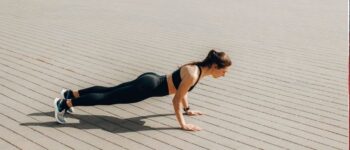A flat belly is a desired physical feature for many women. It is often seen as a symbol of health, fitness, and beauty. There are many reasons why women may want a flat belly. Some women may want to reduce their overall body fat, while others may want to tone and strengthen their abdominal muscles.
There are many benefits to having a flat belly. A flat belly can contribute to a more confident and positive body image. It can also improve overall health and fitness. Studies have shown that people with a lower waist circumference have a reduced risk of developing chronic diseases such as heart disease, stroke, and type 2 diabetes.
There are many different types of ab workouts that can be used to target the lower abdominal muscles. Some common ab workouts include leg raises, alternate heel drops, flutter kicks, mountain climbers, and planks. The best lower ab workouts for women are the ones that are effective and enjoyable.
In this article, we will discuss 09 of the best lower ab workouts for women to get a flat belly. These exercises are all relatively simple to do and can be performed at home with little to no equipment. By incorporating these lower ab workouts into your fitness routine, you can help to tone and strengthen your lower abdominal muscles, which can contribute to a more sculpted and toned appearance.
If you are serious about getting a flat belly, I recommend reading this entire article and incorporating the 09 lower ab workouts into your fitness routine. However, it is important to note that exercise alone is not enough to get a flat belly. You also need to eat a healthy diet and maintain a regular exercise routine.
Warm-Up
Warming up before exercise is important for several reasons.
- First, it helps to prepare your body for physical activity. When you warm up, your heart rate and breathing increase, and your blood vessels dilate. This helps to increase blood flow to your muscles and organs, which prepares them for exercise.
- Second, warming up helps to improve your flexibility and range of motion. This can help to reduce your risk of injury during exercise.
- Third, warming up can help to improve your mental alertness and focus. This can help you to perform better during your workout.
There are many different types of warm-up exercises that you can do. Some common warm-up exercises include:
- Light cardio, such as jogging, jumping jacks, or rowing
- Dynamic stretches, such as arm circles, leg swings, and torso twists
- Sport-specific warm-up exercises, such as dribbling a basketball or swinging a golf club
A good warm-up should last for 5-10 minutes. It should be gradual and progressive, meaning that you should start with light activities and gradually increase the intensity and duration of your warm-up.
Here is an example of a simple warm-up routine:
- 5 minutes of light cardio, such as jogging or jumping jacks
- 10 dynamic stretches, such as arm circles, leg swings, and torso twists
- 5 minutes of sport-specific warm-up exercises, if applicable
You can modify this warm-up routine to fit your own needs and fitness level. For example, if you are new to exercise, you may want to start with a shorter warm-up. Or, if you are training for a specific sport, you may want to include more sport-specific warm-up exercises in your routine.
It is important to listen to your body during your warm-up. If you feel any pain, stop the activity immediately.
Lower Ab Workouts
Leg Raises
How to do a leg raise:
- Lie on your back with your legs extended in the air.
- Keep your core engaged and slowly lower your legs until they are about 6 inches off the ground.
- Hold for a second, then slowly raise your legs back to the starting position.
Benefits of leg raises:
- Leg raises are a great exercise for strengthening and toning the lower abdominal muscles.
- They can also help to improve your flexibility and range of motion in your hips and hamstrings.
Alternate Heel Drops
How to do an alternate heel drop:
- Start in a standing position with your feet shoulder-width apart.
- Keeping your core engaged, slowly lift your right leg and reach towards the ground with your heel.
- Hold for a second, then slowly return your leg to the starting position.
- Repeat on the other side.
Benefits of alternate heel drops:
- Alternate heel drops are a great exercise for targeting the lower abdominal muscles.
- They can also help to improve your balance and coordination.
Flutter Kicks
How to do a flutter kick:
- Lie on your back with your arms at your sides and your legs extended in the air.
- Keeping your core engaged, rapidly flutter your legs up and down.
Benefits of flutter kicks:
- Flutter kicks are a great exercise for working the lower abdominal muscles and improving cardiovascular fitness.
- They can also help to improve your balance and coordination.
Mountain Climbers
How to do a mountain climber:
- Start in a plank position with your hands shoulder-width apart and your body in a straight line from your head to your heels.
- Keeping your core engaged, bring your right knee towards your chest.
- Hold for a second, then return to the starting position.
- Repeat on the other side.
Benefits of mountain climbers:
- Mountain climbers are a challenging exercise that works the entire core, including the lower abdominal muscles.
- They can also help to improve your cardiovascular fitness.
Plank with Leg Raises
How to do a plank with leg raises:
- Start in a plank position with your hands shoulder-width apart and your body in a straight line from your head to your heels.
- Keeping your core engaged, raise your right leg off the ground and hold for a second.
- Then, slowly lower your leg back to the starting position.
- Repeat on the other side.
Benefits of plank with leg raises:
- The plank with leg raises is a variation of the plank exercise that targets the lower abdominal muscles.
- It is a challenging exercise that requires core strength and balance.
Scissor Kicks
How to do a scissor kick:
- Lie on your back with your arms at your sides and your legs extended in the air.
- Keeping your core engaged, slowly cross your right leg over your left leg.
- Hold for a second, then slowly return to the starting position.
- Repeat on the other side.
Benefits of scissor kicks:
- Scissor kicks are a great exercise for working the lower abdominal muscles and improving balance.
- They can also help to improve flexibility in your hips and hamstrings.
Bicycle Crunches
How to do a bicycle crunch:
- Lie on your back with your legs extended in the air and your hands behind your head.
- Keeping your core engaged, bring your right knee towards your chest and rotate your torso to the left so that your right elbow touches your left knee.
- Hold for a second, then return to the starting position.
- Repeat on the other side.
Benefits of bicycle crunches:
- Bicycle crunches are a challenging exercise that works the entire core, including the lower abdominal muscles.
- They can also help to improve your flexibility in your hips and hamstrings.
Russian Twists
How to do a Russian twist:
- Sit on the ground with your knees bent and your feet flat on the floor.
- Holding a weight in both hands, extend your arms in front of you.
- Keeping your core engaged, twist your torso to the right, bringing the weight towards your right hip.
- Hold for a second, then twist back to the starting position.
- Repeat on the other side.
Benefits of Russian twists:
- Russian twists are a great exercise for working the obliques and lower abdominal muscles.
- They can also help to improve your balance and coordination.
Cable crunches
How to do a cable crunch:
- Attach a rope handle to a low pulley cable machine.
- Kneel on the ground with your back facing the cable machine.
- Grasp the rope handle with both hands and extend your arms overhead.
- Keeping your core engaged, lean forward and crunch your body towards the ground.
- Hold for a second, then slowly return to the starting position.
Benefits of cable crunches:
- Cable crunches are a weighted exercise that can be used to target the lower abdominal muscles.
- They can also help to improve core strength and stability.
- Cable crunches can be adjusted to make them more or less challenging, depending on the weight you use and the distance you kneel from the cable machine.
Here are some tips for doing cable crunches safely and effectively:
- Keep your back straight throughout the entire movement.
- Avoid rounding your shoulders or hunching your back.
- Use your core muscles to power the movement, not your arms.
- Don’t pull on the cable handle with your arms.
- Focus on squeezing your abdominal muscles at the top of the crunch.
- Control the weight on the way down.
- Start with a light weight and gradually increase the weight as you get stronger.
If you are new to cable crunches, it is a good idea to have a qualified personal trainer teach you how to do the exercise properly.
Cool-Down
Importance of cooling down after exercise
Cooling down after exercise is just as important as warming up before exercise. It helps your body to recover from your workout and prevents injuries.
When you exercise, your heart rate and blood pressure increase. Cooling down helps to gradually return your heart rate and blood pressure to their resting levels.
Cooling down also helps to remove lactic acid from your muscles. Lactic acid is a byproduct of exercise that can cause muscle soreness and fatigue. Cooling down helps to flush lactic acid out of your muscles and reduce muscle soreness.
Examples of cool-down exercises
There are many different types of cool-down exercises that you can do. Some common cool-down exercises include:
- Light cardio, such as jogging, jumping jacks, or rowing
- Static stretches, such as holding a hamstring stretch or quad stretch for 30 seconds
- Foam rolling
A good cool-down should last for 5-10 minutes. It should be gradual and progressive, meaning that you should start with light activities and gradually decrease the intensity and duration of your cool-down.
Here is an example of a simple cool-down routine:
- 5 minutes of light cardio, such as jogging or jumping jacks
- 5 static stretches, such as holding a hamstring stretch, quad stretch, and calf stretch for 30 seconds each
- 5 minutes of foam rolling
You can modify this cool-down routine to fit your own needs and fitness level. For example, if you are new to exercise, you may want to start with a shorter cool-down. Or, if you are training for a specific sport, you may want to include more sport-specific cool-down exercises in your routine.
It is important to listen to your body during your cool-down. If you feel any pain, stop the activity immediately.
Cooling down after exercise is an important part of any workout routine. It helps your body to recover from your workout and prevents injuries.
Conclusion
In this article, we have discussed 09 of the best lower ab workouts for women to get a flat belly. These exercises are all relatively simple to do and can be performed at home with little to no equipment. By incorporating these lower ab workouts into your fitness routine, you can help to tone and strengthen your lower abdominal muscles, which can contribute to a more sculpted and toned appearance.
Here is a summary of the main points of this article:
- A flat belly is a desired physical feature for many women.
- There are many benefits to having a flat belly, including improved health and fitness, and a more confident and positive body image.
- There are many different types of ab workouts that can be used to target the lower abdominal muscles.
- The best lower ab workouts for women are the ones that are effective and enjoyable.
- The 13 lower ab workouts discussed in this article are all effective and can be done at home with little to no equipment.
Here are some additional tips for getting a flat belly:
- Eat a healthy diet. Eating a healthy diet is essential for overall health and fitness, and it can also help to reduce body fat. Focus on eating plenty of fruits, vegetables, and whole grains. Limit your intake of processed foods, sugary drinks, and unhealthy fats.
- Get regular exercise. In addition to doing lower ab workouts, it is also important to get regular exercise. Aim for at least 30 minutes of moderate-intensity exercise most days of the week.
- Be patient. It takes time and effort to get a flat belly. Don’t get discouraged if you don’t see results immediately. Just keep working hard and you will eventually reach your goals.
If you are serious about getting a flat belly, I recommend incorporating the 09 lower ab workouts discussed in this article into your fitness routine. Additionally, be sure to eat a healthy diet and get regular exercise. With patience and effort, you can achieve your goals and get a flat belly.





Leave a Reply